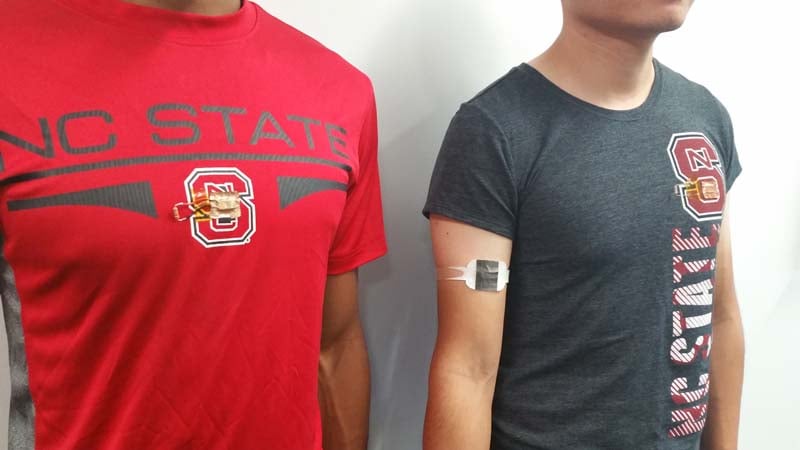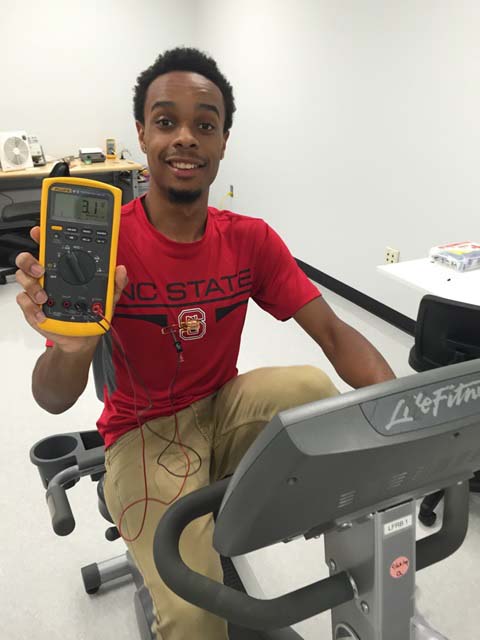There’s no escaping the fact that wearable electronics is huge point of interest in the tech and consumer arenas. The popularity of wearable devices that do everything short of transporting a body up and away is undeniable and sales are brisk. Of course, all of those hot ticket items require some form of power in order to function.
Researchers at North Carolina (NC) State University have embraced that need for operating power with a design for harvesting body heat and converting it into electricity for use in wearable electronics. Experimental prototypes are described as being lightweight and they conform to wearers’ body shapes. An important claim, the prototypes can generate significantly more electricity than similar technologies that came before.
According to associate professor of electrical and computer engineering at NC State and corresponding author of a paper on the work Daryoosh Vashaee, “Wearable thermoelectric generators (TEGs) generate electricity by making use of the temperature differential between your body and the ambient air. Previous approaches either made use of heat sinks, which are heavy, stiff and bulky, or were able to generate only one microwatt or less of power per centimeter squared (mW/C2). Our technology generates up to 20 mW/C2 and doesn’t use a heat sink, making it lighter and much more comfortable.”
The NC State researcher’s design consists of a layer of thermally conductive material that rests on the skin and spreads heat out. The conductive material carries a polymer layer that prevents heat from dissipating into the atmosphere and forcing body heat to pass through a centrally-located TEG that is 1 cm2. Heat not converted to electricity passes through the TEG into an outer layer of thermally conductive material that rapidly dissipates it.
Making it light and easy to wear, the entire system measures 2-mm thick and is very flexible. The prototype contains a TEG measuring 1 cm2, but can be made larger depending on power needs, as per Vashaee.
A breakthrough of sorts, the researchers identified the optimal site on the body for heat harvesting. They report the upper arm as the optimal location for heat harvesting. While the skin temperature is higher around the wrist, the irregular contour of the wrist limited the surface area of contact between the TEG band and the skin. In turn, wearing the band on the chest limited air flow because the chest is normally covered by a shirt.
The researchers incorporated the TEG into T-shirts in which the TEGs were capable of generating 6 mW/cm2 during normal movement and as much as 16 mW/cm2 if the wearer is running. However, Vashaee says, “T-shirt TEGs are certainly viable for powering wearable technologies, but they’re just not as efficient as the upper arm bands.”

A paper title “Wearable thermoelectric generators for human body heat harvesting,” is published in the journal Applied Energy. Its authors are Melissa Hyland, Haywood Hunter, Jie Liu, Elena Veety, and Daryoosh Vashaee, North Carolina State University. The Abstract follows:
 A thermoelectric generator (TEG) can be used to harvest electrical energy from human body heat for the purpose of powering wearable electronics. At the NSF Advanced Self-Powered Systems of Integrated Sensors and Technologies (ASSIST), TEGs are one of the enabling technologies being explored to advance the center’s mission of creating wearable, self-powered, health and environmental monitoring systems. As part of this effort, an exploration of the relevant parameters for maximizing the wearable TEG power output from the body heat and maintaining the body comfort is particularly important. For this purpose, the heat from the body must be directed into TEG with minimal loss, the generator must be designed for maintaining a high temperature differential across the thermoelectric material, and the generator must have a small form factor to maintain the body comfort. In order to address these requirements, an optimum TEG design was developed and experiments were conducted both on a temperature-controlled hot plate and on different body locations including the wrist, upper arm, and chest. The TEG was further fabricated into a T-shirt and the power was recorded for different human activities. Comparison of the experiments on various body locations and on the T-shirt yielded the highest to lowest power generated on the upper arm, wrist, chest and T-shirt, respectively. The prospect of powering a wearable electrocardiogram sensor by a TEG on the upper arm is discussed.
A thermoelectric generator (TEG) can be used to harvest electrical energy from human body heat for the purpose of powering wearable electronics. At the NSF Advanced Self-Powered Systems of Integrated Sensors and Technologies (ASSIST), TEGs are one of the enabling technologies being explored to advance the center’s mission of creating wearable, self-powered, health and environmental monitoring systems. As part of this effort, an exploration of the relevant parameters for maximizing the wearable TEG power output from the body heat and maintaining the body comfort is particularly important. For this purpose, the heat from the body must be directed into TEG with minimal loss, the generator must be designed for maintaining a high temperature differential across the thermoelectric material, and the generator must have a small form factor to maintain the body comfort. In order to address these requirements, an optimum TEG design was developed and experiments were conducted both on a temperature-controlled hot plate and on different body locations including the wrist, upper arm, and chest. The TEG was further fabricated into a T-shirt and the power was recorded for different human activities. Comparison of the experiments on various body locations and on the T-shirt yielded the highest to lowest power generated on the upper arm, wrist, chest and T-shirt, respectively. The prospect of powering a wearable electrocardiogram sensor by a TEG on the upper arm is discussed.
The entire paper is available for purchase for $14.95 at SCIENCE DIRECT. For more details on this developing technology, contact Daryoosh Vashaee via email at [email protected]